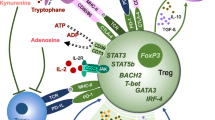Abstract
For many decades, anergy has been used as a descriptive term to describe a state of antigen-specific unresponsiveness. A better understanding of this phenotype was revealed in the 1980s using in vitro model systems. These model systems demonstrated that protein synthesis and mobilization of Ca2+ was required leading to the pursuit of a novel gene(s) that would be unique to the anergy phenotype. Several putative “anergy factors” have been suggested. In this review, we provide an overview of the anergy phenotype and proposed anergy-related genes. To date, no single gene has been described that would completely fulfill the criteria of an “anergy factor”. We review work from our laboratory describing a novel gene that we have termed Gene Related to Anergy In Lymphocytes (GRAIL) that is upregulated in T cells anergized in vitro and in vivo and, following transduction into T cells, reiterates the anergy phenotype.
Similar content being viewed by others
References
Staveley-O'Carroll K, Sotomayer E, Montgomery J, et al.: Induction of antigen-specific T cell anergy: An early event in the course of tumor progression. Proc Natl Acad Sci USA 1998;95(3):1178–1183.
Dresser DW: Effectiveness of lipid and lipidophilic substances as adjuvants. Nature 1961;191:1169.
Blaha P, Bigenzahn S, Koporc Z, et al.: The influence of immunosuppressive drugs on tolerance induction through bone marrow transplantation with costimulation blockade. Blood 2002.
Telander DG, Malvey EN, Mueller DL: Evidence for repression of IL-2 gene activation in anergic T cells. J Immunol 1999;162(3):1460–1465.
Cho EA, Riley MP, Sillman AL, et al.: Altered protein tyrosine phosphorylation in anergic Thl cells. J Immunol 1993;151(1):20–28.
Pape KA, Merica MP, Sillman AL, et al.: Direct evidence that functionally impaired CD4+T cells persist in vivo following induction of peripheral tolerance. J Immunol 1998;160(10):4719–4729.
Tanchot C, Barber DL, Chiodetti L, et al.: Adaptive tolerance of CD4+ T cells in vivo: multiple thresholds in response to a constant level of antigen presentation. J Immunol 2001(4):2030–2039.
Swain SL: Generation and in vivo persistence of polarized Th1 and Th2 memory cells. Immunity 1994; 1(7):543–552.
Gavin MA, Clarke SR, Negrou E, et al.: Homeostasis and anergy of CD4(+)CD25(+) suppressor T cells in vivo. Nat Immunol 2002;3(1):33–41.
Healy JI, Dolmetsch RE, Lewis RS, et al.: Quantitative and qualitative control of antigen receptor signalling in tolerant B lymphocytes. Novartis Found Symp 1998; 215:137–144; discussion 144–145, 186–190.
Su B, Jacinto E, Hibi M, et al.: JNK is involved in signal integration during costimulation of T lymphocytes. Cell 1994;77(5):727–736.
Boussiotis VA, Freeman GJ, Berezvoskaya A, et al.: Maintenance of human T cell anergy: blocking of IL-2 gene transcription by activated Rap1. Science 1997; 278(5335):124–128.
Sebzda E, Bracke M, Tugal T, et al.: Rapl A positively regulates T cells via integrin activation rather than inhibiting lymphocyte signaling. Nat Immunol 2002; 3(3):251–258.
Sundstedt A, Dohlsten M: In vivo anergized CD4+ T cells have defective expression and function of the activating protein-1 transcription factor. J Immunol 1998;161(11):5930–5936.
Kang SM, Beverly B, Tran AC, et al.: Transactivation by AP-1 is a molecular target of T cell clonal anergy. Science 1992;257(5073):1134–1138.
Powell JD, Bruniquel D, Schwartz RH: TCR engagement in the absence of cell cycle progression leads to T cell anergy independent of p27(Kipl). Eur J Immunol 2001;31(12):3737–3746.
Wells AD, Walsh MC, Sankaran D, et al.: T cell effector function and anergy avoidance are quantitatively linked to cell division. J Immunol 2000;165(5): 2432–2443.
Wells AD, Walsh MC, Bluestone JA, et al.: Signaling through CD28 and CTLA-4 controls two distinct forms of T cell anergy. J Clin Invest 2001;108(6): 895–903.
Krummel MF, Allison JP: CTLA-4 engagement inhibits IL-2 accumulation and cell cycle progression uponactivation of resting T cells. J Exp Med 1996;183(6): 2533–2540.
Greenwald RJ, Boussiotis VA, Lorsbach RB, et al.: CTLA-4 regulates induction of anergy in vivo. Immunity 2001;14(2):145–155.
Boussiotis VA, Freeman GJ, Taylor PA, et al.: p27kipl functions as an anergy factor inhibiting interleukin 2 transcription and clonal expansion of alloreactive human and mouse helper T lymphocytes. Nat Med 2000; 6(3):290–297.
Tzachanis D, Freeman GJ, Hirano N, et al.: Tobis a negative regulator of activation that is expressed in anergic and quiescent T cells. Nat Immunol 2001;2(12): 1174–1182.
Yoshida Y, Tanaka S, Umemori H, et al.: Negative regulation of BMP/Smad signaling by Tob in osteoblasts. Cell 2000;103(7):1085–1097.
Yamashiro H, Odani Y, Hozumi N, et al.: Hierarchical signaling thresholds determine the fates of naive T cells: partial priming leads naive T cells to unresponsiveness. Biochem Biophys Res Commun 2002;299(1):148–154.
Korthauer U, Nagel W, Davis EM, et al.: Anergic T lymphocytes selectively express an integrin regulatory protein of the cytohesin family. J Immunol 2000;164(1): 308–318.
Macian F, Garcia-Cozar F, Im SH, et al.: Transcriptional mechanisms underlying lymphocyte tolerance. Cell 2002;109(6):719–731.
Cerdan C, Devilard E, Xerri L, et al.: The C-class chemokine lymphotactin costimulates the apoptosis of human CD4(+) T cells. Blood 2001;97(8):2205–2212.
Kurt RA, Bauck M, Hamma S, et al.: Role of C chemokine lymphotactin in mediating recruitment of antigen-specific CD62L(lo) cells in vitro and in vivo. Cell Immunol 2001;209(2):83–88.
Bachmaier K, Krawczyk C, Kozieradzki I, et al.: Negative regulation of lymphocyte activation and autoimmunity by the molecular adaptor Cb1-b. Nature 2000;403(6766):211–216.
Zhang J, Bardos T, Li D, et al.: Cutting edge: regulation of T cell activation threshold by CD 28 costimulation through targeting Cb1-b for ubiquitination. J Immunol 2002;169(5):2236–2240.
Amsen D, Revilla Calvoe C, Osborne BA, et al.: Costimulatory signals are required for induction of transcription factor Nur77 during negative selection of CD4(+)CD8(+) thymocytes. Proc Natl Acad Sci USA 1999;96(2):622–627.
Anandasabapathy N, Ford G, Bloom D, et al.: GRAIL: An E3 Ubiquitin Ligase that Inhibits Cytokine Gene Transcription 1s Expressed in Anergic CD4+ T Cells. Immunity 2003;18:1–20.
Author information
Authors and Affiliations
Rights and permissions
About this article
Cite this article
Seroogy, C.M., Fathman, C.G. T-cell anergy. Immunol Res 28, 255–264 (2003). https://doi.org/10.1385/IR:28:3:255
Issue Date:
DOI: https://doi.org/10.1385/IR:28:3:255




